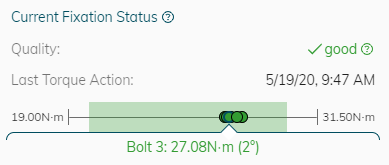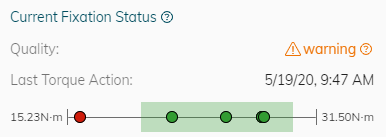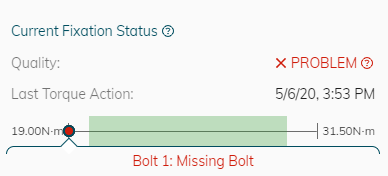Fixation status
< Back To ALIS Manual overview
This article covers a new feature introduced in ALIS version 2020.02 .
The improved method of registering maintenance data can be reviewed here How-to register missing bolts. The Initial Torque condition requires the use of a Angle measuring torque wrench ( ie: Ingersoll QX )
Intro
The Fixation status is a feature that will analyse and inform the user on the fixation status and quality of assets that are maintained by means of an ALIS compatible Torque wrench. For wrenches that include measurement of angle rotation we will also supply an estimation of the initial Torque Condition.
Current Fixation Status
Quality : Is an indication of the status after the last torque maintenance was done
Quality Status | Description |
|---|---|
no rating | The fitting has not received a torque maintenance action yet |
good | All fixation points were torqued within the variance, no bolt is missing |
warning | At least one torque value is out of variance, but not bolt is missing |
PROBLEM | At least one bolt is missing |
![]() These statuses can be used in the MAP filters on the left side to easily find the fittings that have missing bolts or fixation warnings.
These statuses can be used in the MAP filters on the left side to easily find the fittings that have missing bolts or fixation warnings.
Use the Selection tool to then create an appropriate work-order to rectify these issues.

Initial Torque Condition
The initial torque condition is an indicator how the torque condition was before doing the last maintenance. It is important to understand that this condition is not necessarily present anymore since the bolts should be tight again after the last maintenance was performed. The indications stated below can be incorrect if new bolts or nuts where used or if they where un-tightened before torquing them down.
This indicator can give you vital information on the "actual" ( and not "assumed" ) maintenance requirements of your assets and data-drive risk analyses.
Calculated rating
To translate the angle of rotation that is measured from the wrench to a Initial Torque Condition categorization we use the parameters that are put in the Torque settings pages on the ALIS WEbapp.
Select the Settings Icon on the top Right 
Here you can update the settings for the initial torque condition feature. After saving the changes it can take some minutes to reflect the changes in the map view.
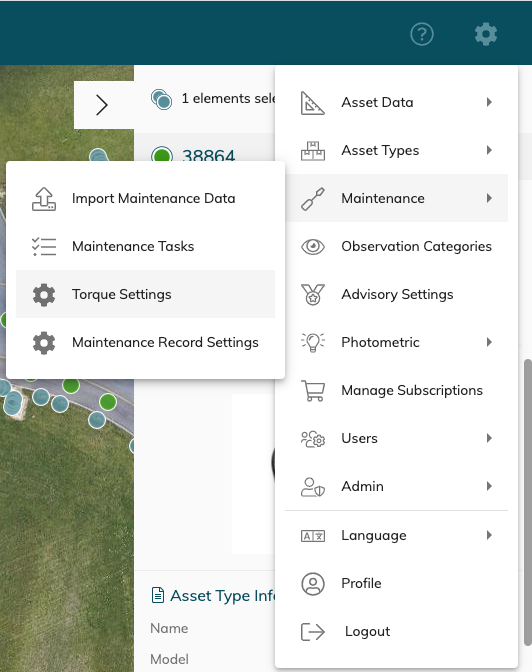
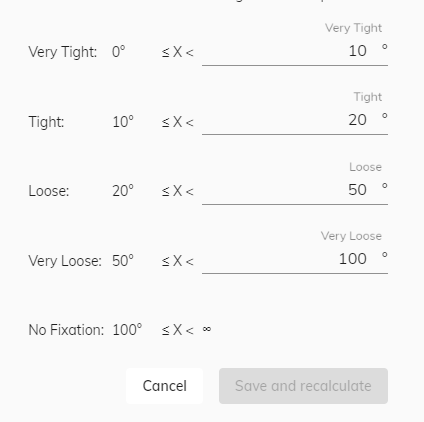
![]() The angle values here are to be chosen and changed with care. The type of wrench - base and bolts used have an impact on the angle moved. You can perform a series of test to deterime the suitable categorization values. Please always request support from you ALIS contact person ( Trough the servicedesk) if you are unsure about changing these values.
The angle values here are to be chosen and changed with care. The type of wrench - base and bolts used have an impact on the angle moved. You can perform a series of test to deterime the suitable categorization values. Please always request support from you ALIS contact person ( Trough the servicedesk) if you are unsure about changing these values.
Maintenance analysis
The maintenance analysis rates the initial torque condition based on the status of all fixation points. This allows for a data-drive decission to lower or increase the maintenance regime applied to this asset (-type).
Calculated Rating | Description |
|---|---|
no rating | This asset has not been torqued with a compatible angle measurement device. |
good (very tight) | In average all fixation points didn't have a high movement and were very tight before doing the maintenance.  |
good (tight) | In average all fixation points didn't have a high movement and were tight before doing the maintenance.  |
warning (loose) | In average all fixation points had a certain amount of movement and thus were already loose.  |
PROBLEM (very loose) | In average all fixation points had a high amount of movement and already were very loose.  |
PROBLEM (no fixation) | In average all fixation points were too loose, so that there was no fixation of the asset anymore.  |
Risk analysis
The risk analysis rates the initial torque condition based on the status of the loosest bolt of an asset since this could lead to an FOD
Calculated Rating | Description |
|---|---|
no rating | This asset has not been torqued with a compatible angle measurement device. |
good (very tight) | All fixation points didn't have a high movement and were very tight before doing the maintenance.  |
good (tight) | All fixation points didn't have a high movement and were very tight or tight before doing the maintenance. |
warning (loose) | At least one fixation point had a high amount of movement and already was very loose.  |
PROBLEM (very loose) | At least one fixation point had a high amount of movement and already was very loose.  |
PROBLEM (no fixation) | At least one fixation point was completely loose, so that there was high risk of FOD. |
< Back To ALIS Manual overview

